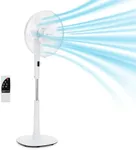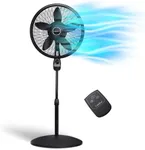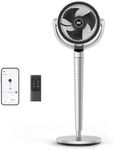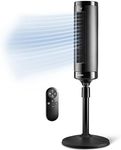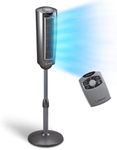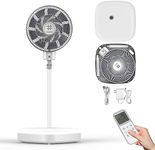Buying Guide for the Best Quiet Pedestal Fans
Choosing the right pedestal fan can make a significant difference in your comfort, especially during hot weather. Pedestal fans are versatile, portable, and can be used in various rooms. When selecting a pedestal fan, it's important to consider several key specifications to ensure you get the best fit for your needs. Here are the key specs to look out for and how to navigate them.Noise LevelNoise level is a measure of how loud the fan is when operating. This is important because a noisy fan can be disruptive, especially if you plan to use it while sleeping or working. Noise levels are usually measured in decibels (dB). Fans with noise levels below 50 dB are considered quiet and are suitable for bedrooms and offices. Fans with noise levels between 50-60 dB are moderate and can be used in living rooms. If noise is not a major concern, fans above 60 dB can be considered. Choose a fan with a noise level that matches your tolerance for sound.
Fan Speed SettingsFan speed settings determine how fast the blades spin and how much air the fan can move. This is important because different situations may require different levels of airflow. Most pedestal fans come with at least three speed settings: low, medium, and high. Some advanced models offer more settings for finer control. If you need a fan for various activities, such as sleeping, working, and cooling a room quickly, look for a fan with multiple speed settings. If you only need it for a specific purpose, fewer settings may suffice.
OscillationOscillation refers to the fan's ability to rotate from side to side, distributing air more evenly throughout the room. This is important for ensuring that the airflow reaches a larger area. Fans with oscillation can cover more space and provide better cooling. Look for fans that offer a wide oscillation angle (typically between 60 to 90 degrees). If you need to cool a large room or multiple people, an oscillating fan is a good choice. For targeted cooling, a non-oscillating fan may be sufficient.
Height AdjustmentHeight adjustment allows you to change the height of the fan to better suit your needs. This is important for directing airflow to different levels, such as when you are sitting, standing, or lying down. Most pedestal fans offer adjustable heights, typically ranging from 3 to 5 feet. If you need flexibility in directing airflow, choose a fan with a wide range of height adjustments. If you plan to use the fan in a fixed position, height adjustment may be less critical.
Blade SizeBlade size affects the amount of air the fan can move. Larger blades can move more air, making them suitable for larger rooms. Blade sizes are usually measured in inches, with common sizes ranging from 12 to 18 inches. For small rooms or personal use, a fan with smaller blades (12-14 inches) may be sufficient. For larger rooms or more powerful cooling, look for fans with larger blades (16-18 inches). Consider the size of the room and your cooling needs when choosing the blade size.
Remote ControlA remote control allows you to operate the fan from a distance, adding convenience. This is important if you want to adjust the fan settings without getting up, especially if you plan to use it in a bedroom or living room. Some fans come with remote controls that allow you to change speed settings, oscillation, and timers. If convenience is a priority, look for a fan with a remote control. If you don't mind manually adjusting the fan, this feature may not be necessary.
TimerA timer allows you to set the fan to turn off automatically after a certain period. This is important for energy savings and convenience, especially if you use the fan while sleeping. Timers can range from 1 to 8 hours. If you want the fan to turn off after you fall asleep or to run for a specific duration, look for a fan with a timer feature. If you plan to use the fan for continuous operation, a timer may not be essential.
